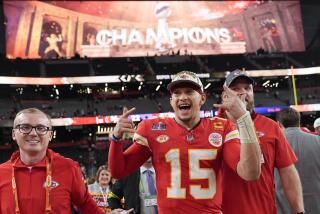They Should Have Two MVP Trophies
SAN DIEGO — The memorable quarterbacks have always been those who prove they have what it takes to bring their teams from behind to win big games.
Joe Montana did it in the Super Bowl. Dan Marino has done it many times. John Elway has done it more often than any quarterback who ever lived.
Brett Favre couldn’t do it for Green Bay on Sunday, although he is the most talented quarterback in football today. And although he made many of the acrobatic plays for which he is famous.
He lost because he made them only in the first 58 minutes.
When Denver pulled ahead with two minutes to play, Favre’s team, a two-touchdown favorite, was beaten.
Elway’s job was to make Favre play catch-up. That was underdog Denver’s best chance to beat a team of storied front-runners. With the help of a unique ballcarrier, Terrell Davis, Elway drove the Broncos to what proved to be the winning touchdown, 31-24.
Favre’s job was then to rescue his teammates.
But for two reasons, he misfired:
* The Packers are so good that they’re seldom behind in the fourth quarter. Thus, Favre is inexperienced in the art of catching up.
* As a quarterback, he isn’t that type.
It takes a precision passer to bring his team down the field in a catch-up mode. Remember Montana throwing all those last-minute passes?
Favre is no Montana. Favre’s long suit is the spectacular play--the incredibly athletic play--and with that kind of football Sunday, he kept the Packers in the game. But after Denver took the game away, he couldn’t take it back.
Two-Way Threat
San Diego’s second Super Bowl experience came on a day that will be remembered for Davis’ big runs. But the truth is that Elway was jointly responsible for professional football’s biggest upset since Joe Namath won Super Bowl III.
Elway and Davis. Davis and Elway. They should have been co-most valuable players.
The threat of Elway’s arm gave Davis a chance to gain all those yards.
The Davis threat gave Elway an opportunity to throw the passes Denver needed to win.
The Packers could have stopped Davis if they had brought a safety up to form an eight-man defensive line.
They could have stopped Elway if they had double-covered all his receivers.
They couldn’t focus on either Davis or Elway because on every play, they were obliged to cover both.
The Great Reader
If Davis is the ablest of all those who have carried the ball in the Super Bowl, what makes him that way?
One thing really.
He is the best reader in, perhaps, the history of running backs.
He reads blocks with more skill than any other ballcarrier I ever saw.
And he reads the right running lane faster than anyone else playing football today.
Davis begins almost every play by hiding behind one or more of his blockers with remarkable patience. And when he comes to a lane that’s open, he darts into it.
On nearly every run, Davis moves into the right lane half a step before any of the defensive players see it. And by the time they react, he has gained five yards or more.
The Davis style is to make one cut and take off. It isn’t speed that makes him, it’s acceleration and vision. His ability to read the field so accurately and so quickly makes it all happen.
Barry Sanders, who leads Davis in rushing yardage every year, is an entirely different sort. Sanders slips and slides like a sandlot player, often gaining, on 10 or more consecutive carries, no more than a yard or two on any one run. Then Sanders runs for 42 yards.
Dorsey Levens is different too. Nobody now in the league combines Levens’ speed, power and moves.
But Davis is more of a craftsman than any other running back the NFL has produced in many years. Because that’s so--and because Elway long ago mastered a game in which he had everything but a running back--they sit today on top of their little world.
More to Read
Go beyond the scoreboard
Get the latest on L.A.'s teams in the daily Sports Report newsletter.
You may occasionally receive promotional content from the Los Angeles Times.










